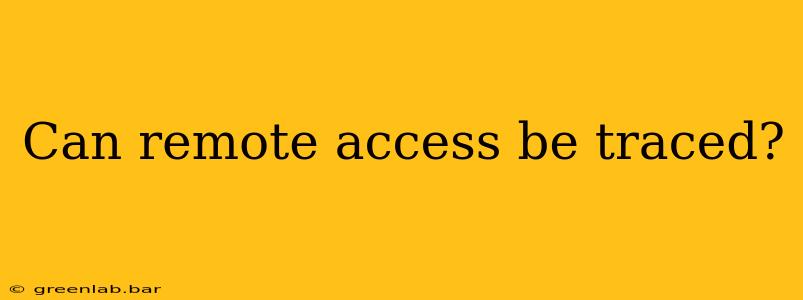The question of whether remote access can be traced is complex. The answer isn't a simple yes or no, but rather depends on several crucial factors. While sophisticated techniques can obscure online activity, leaving no trace is nearly impossible in the digital age. Understanding how remote access is tracked and the methods used to minimize traceability is crucial for both security professionals and individuals concerned about their online privacy.
How Remote Access is Traced
Several methods exist to trace remote access attempts and activities:
1. Network Logs and IP Addresses:
Every time a device connects to a network, it leaves a digital footprint. Network logs, maintained by internet service providers (ISPs), routers, and firewalls, record the IP address of the connecting device, timestamps of connection attempts, and the amount of data transferred. This information is invaluable in identifying the source of a remote access attempt. While an IP address doesn't directly reveal an individual's identity, it can often be traced back to a specific geographic location and, with a warrant, to the subscriber.
2. System Logs and Event Monitoring:
The target device itself also keeps logs. Operating systems maintain detailed records of login attempts, file access, program execution, and other activities. Security Information and Event Management (SIEM) systems aggregate these logs from multiple sources, providing a comprehensive view of the device's activity. These logs can reveal when and how remote access was established, what actions were performed, and even the specific commands used.
3. Remote Access Software Logs:
Many remote access tools, like TeamViewer, AnyDesk, and LogMeIn, maintain their own logs. These logs often contain detailed information about the session, including timestamps, IP addresses of both the accessing and accessed devices, and user credentials (though ideally these should be encrypted). Analyzing these logs can pinpoint the source and duration of the remote connection.
4. Digital Forensics Techniques:
In cases of sophisticated attacks or suspected malicious activity, digital forensics experts employ advanced techniques to uncover traces of remote access. These techniques may involve analyzing memory dumps, examining hard drive contents, and recovering deleted files to identify the methods used and the extent of the compromise.
Minimizing Traceability of Remote Access (for legitimate purposes)
It's important to note that while techniques exist to obscure remote access, these should only be used for legitimate purposes, such as protecting sensitive information or preserving anonymity in specific circumstances. Illegal activities are always traceable and have serious consequences.
Techniques for minimizing traceability include:
- Using a VPN: A Virtual Private Network (VPN) encrypts your internet traffic and masks your IP address, making it more difficult to trace the source of the remote access.
- Tor Network: The Tor network offers a higher degree of anonymity by routing your traffic through multiple relays.
- Encrypted Remote Access Software: Choose remote access tools that utilize strong encryption to protect data in transit.
- Multi-Factor Authentication (MFA): MFA adds an extra layer of security, making it significantly harder for unauthorized individuals to gain access.
Conclusion: The Importance of Security Practices
While complete anonymity is difficult to achieve, understanding the methods used to trace remote access allows both individuals and organizations to implement stronger security measures. Employing best practices, such as regularly updating software, using strong passwords, and implementing multi-factor authentication, significantly reduces the risk of unauthorized access and improves the chances of identifying any suspicious activity. Remember, proactive security is always the best defense.

